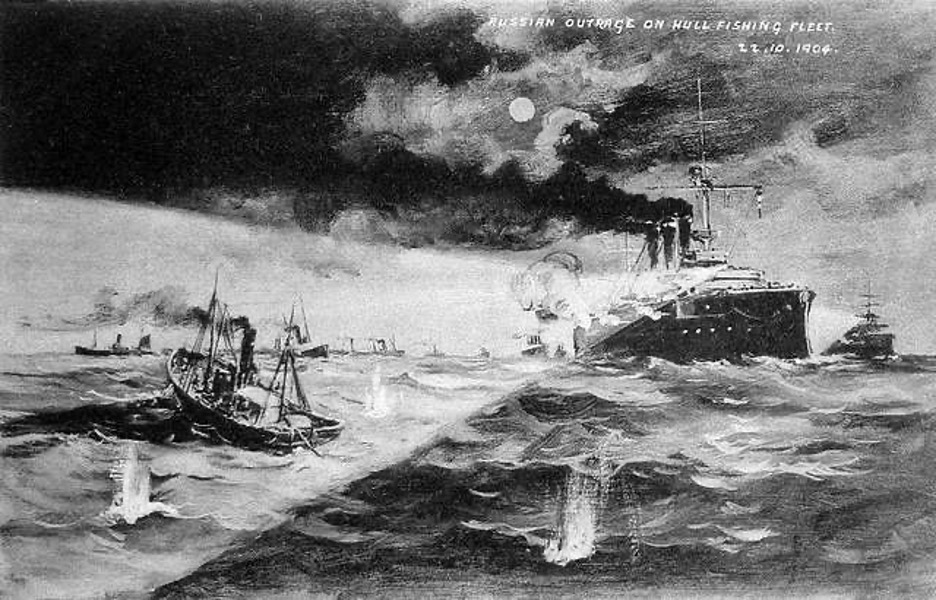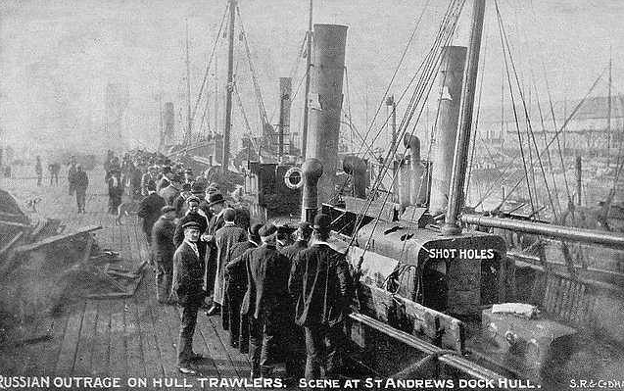The 1904 Dogger Bank Incident: Russia’s Great Mistake
 On the night of October 21st, 1904, the Imperial Russian Navy made a mistake so grave that it nearly landed them at war with the United Kingdom. It was the height of the Russo-Japanese War, and the Russian Baltic Fleet was sailing through a part of the North Sea called Dogger Bank when it spotted several British trawlers. Trawlers that it mistook for Japanese torpedo boats. The Russians opened fire on both the civilian vessels and, somehow, themselves, with dire consequences.
On the night of October 21st, 1904, the Imperial Russian Navy made a mistake so grave that it nearly landed them at war with the United Kingdom. It was the height of the Russo-Japanese War, and the Russian Baltic Fleet was sailing through a part of the North Sea called Dogger Bank when it spotted several British trawlers. Trawlers that it mistook for Japanese torpedo boats. The Russians opened fire on both the civilian vessels and, somehow, themselves, with dire consequences.
The incident caused an international outcry, particularly in Britain, and led to a diplomatic crisis between Russia and the United Kingdom. It became known as the Dogger Bank Incident but has also been called the North Sea Incident, the Russian Outrage (the UK press was merciless), and the more understated, Incident of Hull.
Project 100,000: The Awful US “Meat Grinder” in Vietnam
Thomas Edison, and the Inventions He Didn’t Actually Invent (Video)
Chaos At Sea – What Happened?
Under the command of Admiral Zinovy Rozhestvensky, the Russian Baltic Fleet was sailing the North Sea whilst heading to the Far East, where it was to reinforce the Pacific Squadron stationed at Port Arthur in China. The fleet was made up of numerous warships, including battleships, cruisers, and destroyers, all of which were on high alert.
The fleet believed it had already spotted Japanese cruisers in the region the day before, as well as balloons, and the Admiral had called for his men to keep their eyes peeled. As the fleet approached Dogger Bank, a well-known fishing area, the night was dark and foggy, leading to terrible visibility. At around midnight, a Russian lookout reported seeing small vessels nearby. The already spooked and inexperienced Russian crews jumped to conclusions and began to prepare for an imminent attack.
The warships illuminated the trawlers with their powerful searchlights but didn’t take the time to verify their targets. On Admiral Rozhestvensky’s order, they opened fire and unleashed a barrage of gunfire and shells on the defenseless British fishing trawlers from Hull. Tragically, the trawlers had been mid-haul and had their nets down, meaning they couldn’t even attempt to flee.
The Crane, a British trawler, was sunk with its captain and boatswain losing their lives. At least four other trawlers, including the Mino, Moulmein, and Snipe, were damaged, and six fishermen were hurt. Sadly, one was mortally wounded and died several months later from his injuries.
In a bizarre turn of events, the Russian fleet didn’t even escape unscathed, somehow managing to shoot itself in the foot. In the chaos, the Russians fired upon their cruiser, the Aurora. One sailor and a Russian Orthodox priest were killed. The Russians later tried to hide this embarrassing aspect of the incident, but it was revealed after wireless messages were interpreted by the British Felixstowe station.
The whole sorry incident lasted for about twenty minutes, with the Russians firing sporadically throughout. Eventually, it seems, they realized the enemy wasn’t firing back, and the Admiral called a cease-fire. It was only then the sailors took in their catastrophic mistake. The Russian fleet, shaken and embarrassed, skulked away without trying to help the survivors, unaware of the international uproar that would soon follow.
Fallout of the Cold War: Ozersk City 40, the Other Chornobyl (Video)
America’s Five Most Outrageous Military Experiments (Video)
How Did Russia Make Such a Massive Mistake?
Suffice it to say the Dogger Bank Incident was a mistake of epic proportions. But how exactly did an entire Russian fleet end up firing on a group of defenseless fishermen? Was it all down to ineptitude? Well, at the heart of the error lay heightened paranoia and a lack of proper naval training.
Firstly, the Russian Baltic Fleet was on high alert, plagued by fears of encountering Japanese forces. The Russo-Japanese War had already seen significant losses for Russia, contributing to a sense of desperation and hyper-vigilance. This anxiety was exacerbated by rumors and false reports of Japanese ships lurking in European waters.
Russian intelligence had warned the fleet that enemy intelligence was active in the region. The Russians were particularly concerned about Torpedo boats, a technology all the major navies had recently developed. These small ships had the potential to damage and sink warships much larger than them and were incredibly difficult to spot. The constant fear of torpedo boat attacks had left its mark on the Russian navy’s sailors and commanders.
Not long before the incident, Admiral Rozhestvensky had been warned that Japanese torpedo boats had been spotted in the region. According to the report the ships “only showed lights on the mizzenmast-head so that at a distance, they might be taken for fishing boats”. The Admiral took this report at face value and ordered his ships to speed through the area.
The Admiral wasn’t alone in his paranoia, the Dogger Bank Incident wasn’t the first time Russian ships had fired on innocent fishermen. The Russian fleet had already fired on fishermen carrying consular dispatches to them near the Danish coast. Supposedly the only reason those fishermen had survived was because the Russian fleet could barely shoot straight.
This leads to the next reason the incident happened at all: poor training. The Russian fleet was largely made up of inexperienced and poorly trained rookie sailors. Many of them had never seen combat before and didn’t know what to look for when spotting enemy ships.
Communication failures within the fleet further amplified the problem. Orders were given and executed without thorough verification, and the chaotic environment onboard prevented clear communication. The Russian command structure also played a role, as Admiral Rozhestvensky’s decision to open fire was not sufficiently challenged or scrutinized.
Lastly, technological limitations and poor visibility on that fateful night contributed to the tragic mistake. The primitive radar and signaling systems of the time were inadequate for distinguishing between friendly and enemy vessels, especially in the dark and foggy conditions of the North Sea. These factors combined led to a perfect storm of errors and resulted in the tragic Dogger Bank Incident.
Aftermath
The Dogger Bank Incident came with major repercussions and led to a dire diplomatic crisis between Russia and Britain. The problem wasn’t so much that the Russians had attacked the civilian boats; it was that they’d then run off without trying to help them.
The British public was outraged, with the newspapers going as far as calling the Russians “pirates.” The Times was particularly vitriolic, stating:
“It is almost inconceivable that any men calling themselves seamen, however frightened they might be, could spend twenty minutes bombarding a fleet of fishing boats without discovering the nature of their target.”
The two powers were on the brink of war and the Royal Navy ordered 28 of its battleships to prepare for action while also ordering its cruiser squadrons to shadow the Russian fleet. The British government demanded an immediate explanation as well as compensation. Considering the Anglo-Japanese Alliance of the time, this diplomatic crisis was terrifying for all involved.
To try and calm the stormy waters, Russia quickly issued an apology and agreed to an international investigation. On November 25, 1904, the two parties signed a joint agreement in which they agreed to let an international commission based on the Hague Convention deal with the incident. This commission ultimately concluded that the Russian fleet had acted recklessly and without proper cause, but it also made it clear that the incident should not be considered an act of war. As a result, Russia agreed to pay £66,000 (equivalent to millions today) in compensation to the British fishermen and their families. Relations remained frosty but war was averted.
Conclusion
In the long term, tensions once again eased between Russia and England, but the incident served to highlight the precarious nature of alliances and enmities in early 20th-century Europe. As has so often been the case throughout human history, frayed nerves were always on the verge of starting something catastrophic. We all know what happened in 1914, after all.
For Russia, the incident didn’t just leave it with egg on its face. The Dogger Bank Incident also delayed the Baltic Fleet’s arrival in the Far East, something that contributed to its eventual defeat by the Japanese at the Battle of Tsushima in May 1905. A battle during which Russia lost over 5000 men and a massive chunk of its Navy.
The Dogger Bank Incident is a reminder that mistakes, big and small, can have dire consequences. While it did not lead to war immediately, it can be argued that the incident contributed to Russia’s defeat to Japan. A loss that some historians have argued upset the balance of power in Europe, something that contributed to the European powers going to war in 1914.

